Land Rover FAQ: 101 Forward Control, Power Trailer
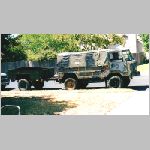
|
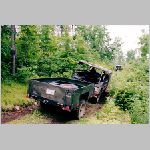 |
101FC with Power
Trailer (2001) |
Offroad in Canada (2002) |
The Ministry of Defense specification for the 101" Forward Control, a gun
tractor for the 105" Light Gun, included a power driven trailer with a 1
tonne capacity off road. The idea was to have the 101 carry the 6 man
crew with kit, the trailer carry 1 tonne of 105mm shells and then the gun
would be towed behind the trailer.
According to a person on testing in Libya the power trailer wasn't all that
useful until they got into soft sand. Then it made the difference between
getting stuck and getting through. Another story from testing is of a
demonstration for the military. According to a 2nd hand source, the 101 and
trailer was making a tight turn with the trailer drive engaged. The trailer
drivetrain bound up and the 101 rolled onto its side. Righting the 101 was
simply done by putting the 101 and trailer in reverse. Sometime after this
event the power trailer was deleted from the 101 specification. One say it
was because of the roll over incident. An engineer at Rubery-Owen at the
time says that the the decision was due to cost.
Two types of power trailer were built for the 101FC. Those by the Rubery-Owen
company is the most well known. Scottorn also made at least one trailer known
as the Bushmaster. Originally it was developed for a Series IIA 109. A
trailer with the UK registration "EXO 384" was photographed being towed by a
Luxembourg 101FC
with VRN 3700. The Luxembourg Army trialed the trailer circa 1976, but decided
not to make a purchase. Instead they bought 30 1-ton un-powered trailers.
3700 has since had its trailer drive removed, but as of 2002 still had the
air hose for the brakes.
Both Rubery-Owen and Scottorn Bushmaster had cargo capacities of 1500 lbs. The Rubery-Owen trailer weighs 938 kg.
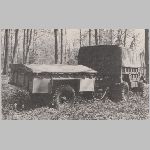
|
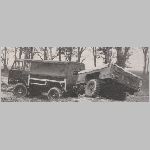
|
Scottorn
Bushmaster |
Rubery-Owen |
The Rubery-Owen power trailed was used in the 1975 Joint Services Trans Sahara
expedition led by Tom Sheppard. This was the first self-sufficient crossing from West to East.
The vehicles on the expedition were 4 101FCs with 2 power trailers. The
Ministry of Defense releast to Rubery-Owen
two of the prototypes (#1 and #5) to refurbish for the expedition.
In the Sahara the
power trailers had some issues. The drive was noisy and vibrated. Spring
mounts broke. It was reported in a trailing wind the 101s with the trailers
tended to overheat. All told 101FC + trailer + cargo was 11,200 lbs.
Near the end, one trailer had all leaves but one break on one spring which
resulted in the abandoning of one trailer near Port Sudan on 16 April 1975.
The trailer drive from this trailer was shipped back to the UK for study.
The trailer drive for the trailer was a PTO that attached to the rear PTO
hole on the back of the transfer box. From there two propellor shafts
connected at a strut bring the drive to a coupling that passed through
the rear crossmember. The trailer connects to the 101 via a male bit that
fits into female receptor on the crossmember. The two are held together via
a perimeter chain system. The trailer tongue is articulated to allow the
trailer to pitch up and down, rotated left and right and twist clockwise and
anti-clockwise in respect to the 101. This is a "treble hooks joint nose
coupling". A Scottorn Bushmaster advertisement claims that this coupling
allows articulation 60 degrees in all directions. To achieve this, there are
two
universal joints betwen the male coupler and the solid part of the trailer
tongue. Then the drive passes through a bearing, and through two more
universals to get down to the differential. The differential is the same
Salisbury as found on 101FCs. The tires and rims are the same too.
Photos of trailer drive that attaches to the 101:
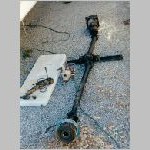
|
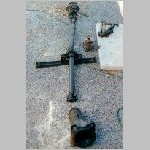
|
Drive from
front |
Drive from
rear |
The power trailer had 3 drop legs (on some trailers they had wheels and some
without) so that the trailer could be kept flat when the 101 was elsewhere.
Braking is an "inverted vacuum system".
101FCs with the trailer drive have a vacuum gauge on the dash.
Vacuum is pulled off of the intake manifold to a tank.
From there is a coupling that Ts off of the main hydraulic brake
line to a slave cylider that actuates a valve on the vacuum system. This
brings the vacuum to the trailer to brake the trailer. Additionally the
trailer can pass the vaccuum line back to the howizer to actuate the brakes
on the gun as well.
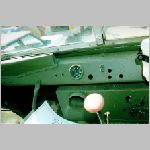
|
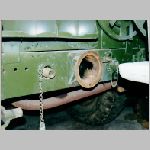
|
| Vacuum Guage |
Trailer Drive Coupling
and vaccuum hose connector
on prototype 01SP17 |
Since these trailers were prototypes. They varied a bit. A source
on the MoD project says that they were built in pairs with minor differences.
Many shows the tail lights in horizontal alignment. At least one had them
aligned vertically.
Here are some measurements:
| Source |
Width |
Length
of load bed |
Height |
| 1972 brochure |
73.00 inches |
90.36 inches |
54.50 inches |
| 267957/3 |
72.50 inches |
93.0 inches |
53.75 inches |
How many power trailers were made is open to debate. Prototype #7 is known
as is 267957/3. This implies at least 10. Mr. Wally Dugan, the former
curator at the Museum of Army Transport, Beverly, Yorkshire, related that
they were built in pairs. This would imply that a prototype #8 existed and
maybe a production #4. 01SP43, 02SP00, 02SP01 and 15EN07 are known to be trailer
VRNs in photographs and written documenation. Other possible VRNs are: 01SP42,
01SP44, 05SP10 and 05SP12.
Differences:
- The 1975 trans-sahara mentions breaking all leafs but one (which implies that proto #1 and proto #5 had many leafs). Dunsfold (proto #5)
and Beverly (proto #3) trailers show a spring pack with many leaves. Gaydon's (unknown) and production/3 have only 2 leafs--similar to the 101FC.
- Tail light arrangements.
- verticle arraingment: 01SP43 proto #5
- horizontal arraingment, outboard, no triangles: proto #3
- horizontal arraingment, inboard, triagles outboard: 02SP01 proto #1, and production #3
Rubery-Owen Trailers
Chassis
Number |
Year |
Plate Location |
Location |
Last Seen |
Notes |
| Prototype #1 |
1967 |
Unknown |
Unknown |
April 1975 |
VRN: 02SP01. On Trans-Sahara Expedition
Broke spring and abandoned near Port Sudan 16 April 1975.
Drive shipped back to UK |
|
Chassis
Number |
Year |
Plate Location |
Location |
Last Seen |
Notes |
| Prototype #2 |
Unknown |
Left side of tongue |
Museum of Army Transport
Beverly, Yorkshire, UK |
Spring 2002 |
02SP00 |
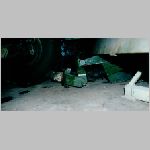
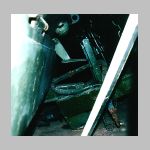
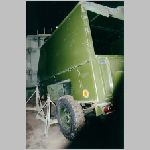
|
|
Chassis
Number |
Year |
Plate Location |
Location |
Last Seen |
Notes |
| Prototype #3 |
Unknown |
Unknown |
Unknown |
Unknown |
|
|
Chassis
Number |
Year |
Plate Location |
Location |
Last Seen |
Notes |
| Prototype #4 |
Unknown |
Unknown |
Unknown |
Unknown |
|
|
Chassis
Number |
Year |
Plate Location |
Location |
Last Seen |
Notes |
| Prototype #5 |
1971 |
front left side
of body |
Dunsfold Land Rover Trust |
Spring 2002 |
VRN: 01SP43 On Trans-Sahara Expedition |
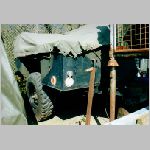
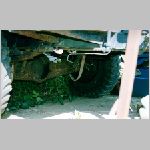
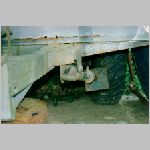
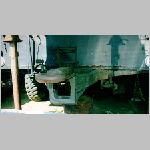
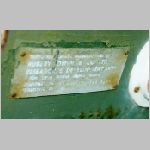
|
|
Chassis
Number |
Year |
Plate Location |
Location |
Last Seen |
Notes |
| Prototype #6 |
Unknown |
Unknown |
Unknown |
Unknown |
|
|
Chassis
Number |
Year |
Plate Location |
Location |
Last Seen |
Notes |
| Prototype #7 |
Unknown |
Left side of tongue |
Australia |
Summer 2003 |
Commonly photographed with a 101FC prototype |
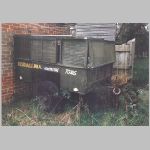
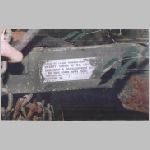
Photos: A. Johnson
|
|
Chassis
Number |
Year |
Plate Location |
Location |
Last Seen |
Notes |
| Prototype #8 |
Unknown |
Unknown |
Unknown |
Unknown |
|
|
Chassis
Number |
Year |
Plate Location |
Location |
Last Seen |
Notes |
| 267957/1 |
Unknown |
Unknown |
Unknown |
Unknown |
|
|
Chassis
Number |
Year |
Plate Location |
Location |
Last Seen |
Notes |
| 267957/2 |
Unknown |
Unknown |
Unknown |
Unknown |
|
|
Chassis
Number |
Year |
Plate Location |
Location |
Last Seen |
Notes |
| 267957/3 |
1973 |
Left side tongue |
USA |
August 2003 |
|
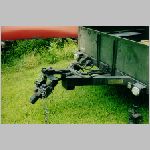
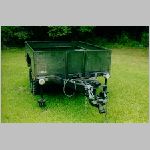
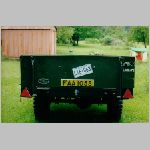
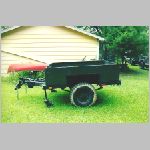
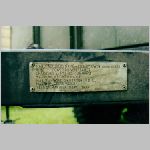
|
|
Chassis
Number |
Year |
Plate Location |
Location |
Last Seen |
| 267957/4 |
Unknown |
Unknown |
Unknown |
Unknown |
|
The following trailers are not matched to chassis numbers
Chassis
Number |
Year |
Plate Location |
Location |
Last Seen |
Notes |
| Unknown |
Unknown |
Unknown |
British Motor Industry
Heritage Trust
Gaydon, Warwickshire, UK |
Spring 2002 |
|
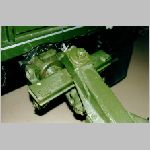
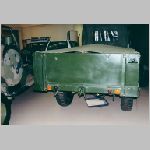
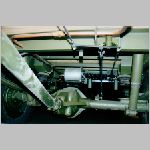
|
|
Chassis
Number |
Year |
Plate Location |
Location |
Last Seen |
Notes |
| Unknown |
Unknown |
Unknown |
Australia |
Fall 2004 |
Photos in eBay auction, but no bids |
Chassis plate examples:
Manufacturers Name. Rubery Owen (Warrington) LTD.
Title. Power Driven Trailer
Chassis or Serial No. 267957/3
Maximum Weight on Axle.
Maximum Load on Drawing Vehicle.
Maximum Gross Weight.
Year of Manufacture. 1973
Prototype Chassi Manufactured by
Rubery Owen & Co. Ltd.
Research & Development Div.
1 Ton, 2W/1L Power Drive Trailer
Contract No. A/TS/WV/7791/AC12AL
Prototype No. 5
Prototype Chassis Manufactured by
Rubery Owen & Co. Ltd.
Research & Development Div.
1 Ton, 2W/1L Power Drive Trailer
Contract No. A/TS/WV/7791/AC12AL
Prototype No. 7
Two examples shown in print in the British Defense Equipment Guide. Probably
it is the same photo reprinted.
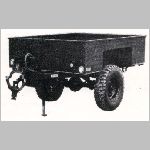
|
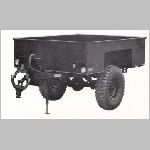
|
| 1970 |
1974 |
A number of 101FCs are known to have had the the trailer drive fitted. These
include:
101/FC/1 (01SP47 later JKV 407) prototype
101/FC/2 (01SP13) prototype
101/FC/3 (01SP14, laster OAB 266P) prototype
101/FC/4 (01SP15) prototype
101/FC/5 (01SP16) prototype
101/FC/6 (01SP17) prototype
101/FC/7 (???) prototype
101/FC/8 (HXC 805H) prototype
95600003A (CXC 347X)
95600004A (??)
95600016A (HXC 677L and later FAA 105S)
95600022A (76FL64) West to East Expedition
95600023A (76FL65) West to East Expedition
95600024A (76FL66) West to East Expedition
96100001A (04SP07 or EXC 384L)
96100019A (05SP11)
96400007A (04SP08)
96400008A (3700) (Scotthorn-Bushmaster PTO) Luxembourg Army
Possible trailer drive 101s:
96100010A (05SP10). This may have been renumbered to 96400006A and made into a prototype radio body
95600002A
Prototype in Australia, VRN unidentified
101/FC/8C (VXC 754K) prototype (inconclusive from photo)
02RN37
Many thanks to Wally Dugan, John Hill, A. Johnson, Keith Miller, Darren Parsons, and Jean-Claude Thies for help in researching this.
Last modified 20 October 2004.
Comments? Send mail to
Benjamin Smith







